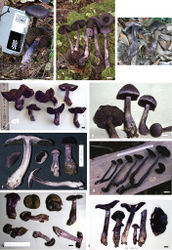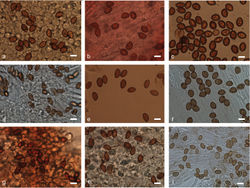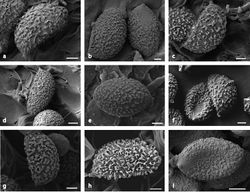Cortinarius palatinus
| Notice: | This page is derived from the original publication listed below, whose author(s) should always be credited. Further contributors may edit and improve the content of this page and, consequently, need to be credited as well (see page history). Any assessment of factual correctness requires a careful review of the original article as well as of subsequent contributions.
If you are uncertain whether your planned contribution is correct or not, we suggest that you use the associated discussion page instead of editing the page directly. This page should be cited as follows (rationale):
Citation formats to copy and paste
BibTeX: @article{Harrower2015MycoKeys, RIS/ Endnote: TY - JOUR Wikipedia/ Citizendium: <ref name="Harrower2015MycoKeys">{{Citation See also the citation download page at the journal. |
Ordo: Agaricales
Familia: Cortinariaceae
Genus: Cortinarius
Name
Cortinarius palatinus Harrower sp. nov. – Wikispecies link – Pensoft Profile
Diagnosis
Similar to Cortinarius neotropicus sp. nov. but differs in having shorter basidiospores and absence of caulocystidia. Unique molecular synapomorphies at pos. 39 (ITS1), 524, 618, 649, 651, 672 (ITS2) of our alignment.
Type
COSTA RICA. San Jose: Perez Zeledon, Villa Mills, CATIE Experimental Forest, 9°33'03"N; 83°40'56"W, 2880 m alt., (Quercus costaricensis), 21 June 2003, R.E.Halling 8411 (holotype: NY 796168).
Etymology
Named for the color palatinate, a shade of violet.
Description
Pileus 30–50 mm wide, convex to plano-convex, surface dry, densely squamulose, appressed toward margin, erect on disc, violet (15C5–8, 15D5–8, 15E5–8, 16C5–8, 16D5–8, 16E5–8), red with KOH. Lamellae adnexed, close, violet, concolorous with pileus, soon assuming brown colors, up to 1 cm broad, edges even to uneven. Stipe 80–120 mm long, 10–14 mm broad, equal or subclavate, strict or curved, dry, upper half violet, fibrillose–striate; lower half pale violet, fibrillose, base violet (15C5–8, 15D5–8, 15E5–8, 16C5–8, 16D5–8, 16E5–8). Universal veil pale violet. Context pale violet, unchanging. Smell mild. Taste mild.
Basidiospores 11–15 µm × 7–9.5 µm, means = 12–13 µm × 8–8.5 µm, Q = 1.39–1.59, Q means = 1.40–1.53 (150 spores, 6 specimens). Amygdaloid, strongly verrucose, plage present under SEM. Basidia 2- and 4-spored, clavate, (20–) 30–40 × 10–15 µm. Cheilocystidia present but not abundant in younger specimens, lageniform, brown or grey in KOH, (35–) 60–95 (–100) µm × (11–) 13–25 (–30) µm. Pleurocystidia abundant, lageniform, brown or grey in KOH, (40–) 50–80 (–105) µm × (10–) 15–25 (–40) µm. Pileipellis a trichoderm composed of hyphae up to 20 µm wide, multi-septate, with brown contents in KOH, terminal hyphae blunt-ended, sometimes aciculate. Clamp connections present.
Ecology and distribution
Known from Perez Zeledon and San Gerardo de Dota in Costa Rica. Associated with Quercus copeyensis, Quercus seemannii, and Quercus costaricensis on acidic soils. Occurring mid-June to mid-July. Elevation 2220–2280 m.
Other specimens examined
Costa Rica, San Jose, Perez Zeledon, Villa Mills, CATIE Experimental Forest, 9°33'03"N; 83°40'55"W, 2880 m, (Quercus costaricensis), 22 June 1995, R.E.Halling 7450 (NY 79537). San Jose, San Gerardo de Dota, Albergue de Montana, Savegre, ~5 km SW of Cerro de la Muerte, 9°33'02"N; 83°48'27"W, 2500 m, (Quercus copeyensis, Quercus seemannii), 20 June 1994, R.E.Halling 7307 (NY 34724). San Jose, Perez Zeledon, Villa Mills, CATIE Experimental Forest, 9°41'56"N; 83°56'31"W, 2850 m, (Quercus costaricensis), 12 June 2000, R.E.Halling 8184 (NY 795933). San Jose, San Gerardo de Dota, Albergue de Montana, Savegre, ~5 km SW of Cerro de la Muerte, 9°33'02"N; 83°48'27"W, 2220 m, (Quercus copeyensis, Quercus seemannii), 10 July 2001, R.E.Halling 8004 (NY 460906). San Jose, Perez Zeledon, Villa Mills, CATIE Experimental Forest, (Quercus costaricensis), 23 June 2001, E. & A. Horak (ZT 10422).
Discussion
Cortinarius palatinus sp. nov. is treated as ‘Cortinarius sp. CR2’ in Harrower et al. (2015)[1]. It occurs in the same oak forests and at the same elevation as Cortinarius neotropicus sp. nov. It can be distinguished from Cortinarius neotropicus sp. nov. by its larger and more heavily verrucose basidiospores and pale violet context. Caulocystidia were found in Cortinarius violaceus and Cortinarius neotropicus sp. nov., but not in Cortinarius palatinus sp. nov. Cortinarius atrotomentosus sp. nov. differs from Cortinarius palatinus sp. nov. by its wider and olive colored stipe. These two species appear to be most closely related (Fig. 1). Cortinarius atrotomentosus sp. nov. occurs on limestone soil and Cortinarius palatinus sp. nov. on acidic soil. This is the same species that was referred to as Cortinarius violaceus by Halling and Mueller (2005)[2] from the Talamanca Mountains of Costa Rica (NY795933 illustrated).
Original Description
- Harrower, E; Bougher, N; Winterbottom, C; Henkel, T; Horak, E; Matheny, P; 2015: New species in Cortinarius section Cortinarius (Agaricales) from the Americas and Australasia MycoKeys, (11): 1-21. doi
Images
|
Other References
- ↑ Harrower E, Bougher N, Henkel T, Horak E, Matheny P (2015) Long-distance dispersal and speciation of Australasian and American species of Cortinarius sect. Cortinarius. Mycologia 107(4): 697–709.
- ↑ Halling R, Mueller G (2005) Common Mushrooms of the Talamanca Mountains, Costa Rica. The New York Botanical Garden, 1–195.



